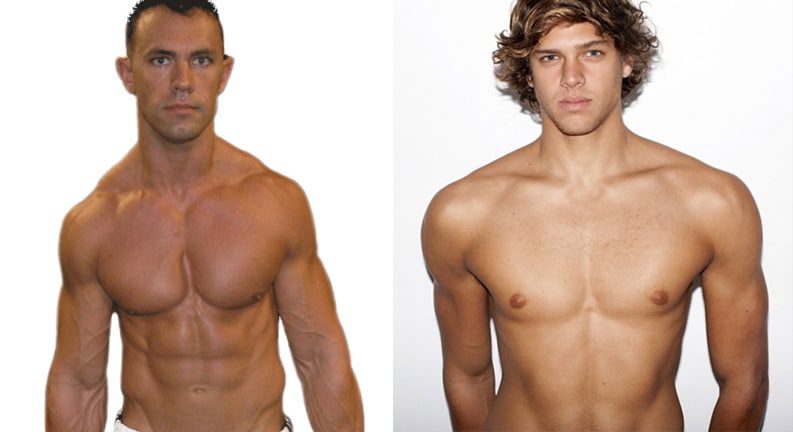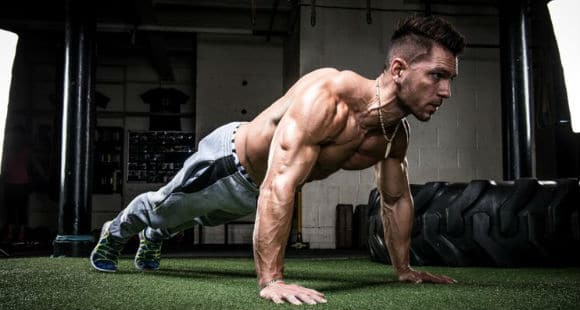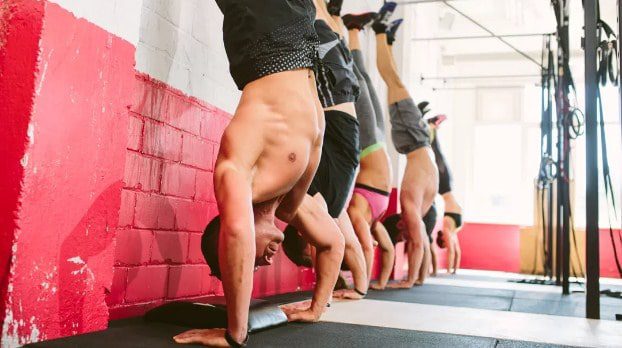A big component of the ultimate physique is shoulders. How big are your shoulders compared to your waist?
This ratio is crucial for determining how “attractive” you are people.
(Yes, there is an attraction scale!)
So how can you build a pair of dominating shoulder caps, round and thick like boulders?
What if I told you broad, sexy shoulders can be sculpted with a few simple bodyweight movements? You’d think I should be institutionalized, right?
Well, prepare to come join me: It’s more than doable to get your physique on-point with calisthenics.
In this end-all, be-all guide, I’ll provide the inside scoop on why strong shoulders are beneficial, the different exercises you can do to create boulder shoulders, how to train them, and example workouts to get the ball rolling.
Read Also: The Ultimate guide to shoulder workouts for women
Should Muscle Anatomy – The Three Deltoids
Before we go any further we must understand the anatomy of the shoulders in order for you to train them fully.
You may not know that the shoulder is composed of three major muscles and hitting each one with bodyweight exercises can be an effective way to get the most out of your workouts.
The Anterior
The anterior deltoids are found at the front of your upper arm, leading to your shoulder. It is worked by exercises that see you move your arms out in front of you with push-ups being a particularly effective way to target the anterior deltoids.
The Medial
The medial deltoid muscle sits to the side of the anterior and is worked by exercises that involve you moving your arms away from you, either above your head or to the side.
The Posterior
The posterior deltoid sits towards the back of your upper arm and can be targeted with rows and flys.
The Rotator Cuff
The rotator cuff is formed of four small muscles. A tear of these muscles may lead to pain around the shoulder blade.
Why Train Your Shoulder Muscles?
The shoulders can often be forgotten when talking about major muscle groups. However, you shouldn’t fall into the trap of underestimating just how important they are.
Your shoulders are involved in almost every single you make with your upper body. As a result, if you want to improve the mobility and strength of muscles connected to your shoulder muscles you have to train them as well.
Skipping over shoulders to focus on more popular muscle groups could be a recipe of injury and in this guide we look at some of the best bodyweight workouts you can do at home, or just about anywhere to exercise your shoulders.
The Ultimate List Of Bodyweight Shoulder Exercises
Pike Push-ups
The original, classic exercise, this beginner movement is where most people will start their bodyweight shoulder journey.
How to: Get into a downward dog position, with elbows flared out. You can also do this with your feet on a box or elevated platform.
Bend your arms, bringing your head to the ground, then push back up, straightening out those arms.
It works like a push-up with added strain on your shoulders.
Wall Walks
A fun and challenging movement, wall walks are good for finishers and hitting multiple heads of the shoulder.
How to: Start by laying on the ground, belly down, with your feet against a cleared wall.
Begin to walk up the wall with your feet, bringing your body closer by walking your hands back.
Get all the way up to an assisted handstand position, then retrace your steps back to the ground.
Static Handstand
Another classic, the handstand is a standard of shoulder strength.
How to: Get on your hands, body straight up in the air. Balance and maintain this hold. For assistance, use a wall and lean against it.
Hold for the desired amount of time, usually a range between 20 seconds and a full minute.
Handstand Push-ups
This is where things get serious. Handstand push-ups are no joke, and are by far the best bodyweight shoulder exercise out there.
How to: Start in a static handstand or assisted static handstand. Slowly bend your elbows, bringing your body to the ground. Push back up, maintaining balance.
Essentially pike push-ups and handstands on steroids, the handstand push-up is a benchmark you should be aiming for.
Bridge Push-ups
An interesting – and probably new to you – movement, bridge push-ups are great for keeping your shoulders from rounding in front.
How to: Start by laying on the ground, belly up. Get into bridge position – hands and feet on the ground, back rounded in space.
Flare your elbows out for a comfortable movement. Bring your upper body down to the ground by bending your elbows.
Your legs will move some, but don’t allow your glutes and lower body to relax on the ground. Push back up.
Technically, this is a posterior exercise to combat all of the anterior work we give our shouders.
Training Shoulders

Doesn’t seem like a ton of exercises, does it?
The reason why we aren’t going into detail over random push-up variations and other obscure movements is because basics are best.
These exercises will give you the necessary muscle for thick, rounded shoulder caps.
And in any case, shoulders are actually secondary body parts, when compared to your pecs, LATs, glutes, and quads.
I like to think of them as the hamstrings of the upper body; they give additional support to your chest and back muscles, physiologically keeping them connected.
So, how do you train ‘em?
Benefits Of Having Strong Shoulders

First off, does having built shoulders mean anything?
Short answer: Of course.
Long answer: Having strong shoulders opens up a whole world of possibilities.
Benefits include:
- Added strength to your back and chest workouts. Your shoulders attach your neck, back, and chest together; having them as strong as possible gives you more power and strength for those big lifts like weighted pull-ups, planche push-ups, and crazy dips.
- Full-cap look creates an incredible physique. If your goal is to improve your physique, then rounded, filled shoulder caps are what you’re looking for. It signals you have dense muscle in your upper traps and all sides of the shoulder (front, lateral, back).
- Applies to real-world lifts. Moving furniture, carrying kids around, and playing sports all involve some shoulder capacity. Make these daily activities a breeze with highly developed shoulders.
- Literally makes you more attractive. Scientifically, the wider you are on top (and the slimmer you are in the midsection) the better looking you will be to anyone who sees you. Want proof? Check out these side-by-sides and tell me which one is more appealing:

Getting that V-shape everybody covets is the name of the game. Here’s how you play…
Read Also: How to Do Skull Crushers
How Often Should You Train Shoulders?
As mentioned previously, shoulders are actually smaller muscles that attach your front to your back.
This means training them is slightly different than training chest or back. You don’t need as much stimulus to get the desired results due to physical size of the muscle.
Also, it doesn’t take much to fatigue your shoulders.
Because they are being utilized in both back and chest workouts (normal push-ups and pull-ups use some amount of shoulder work), if you do those and then get to a shoulder movement, it can’t handle as much.
If you’ve ever wondered why your shoulders seem weaker than other body parts, this is why.
For recovery purposes and maximum results, you should train shoulders two times a week at the most.
This gives you two to three days rest. Of course, this isn’t 100% true if you do a back or chest day during that span – your shoulders will be complementing other muscles during movements.
To begin a shoulder workout regimen, two days each week would be ideal.
Structuring Shoulder Workouts

While it appears counterintuitive, it is best to put shoulders with another, bigger body part, such as LATs or pecs.
While this will fatigue the shoulders a little before doing real shoulder work, it’s the best for real-world application.
When you use your shoulders for daily things, you’re probably also using your back and/or chest.
Therefore, compound movements are crucial for your well-being. Shoulders + Other Body Part = Most Strength.
After one or two compound bodyweight movements, then you can do your two to three shoulder exercises.
Example:
- Chest exercise 1: 3 sets of 5-15 reps
- Chest exercise 2: 3 sets of 5-15 reps
- Shoulder exercise 1: 3 sets of 5-15 reps
- Chest exercise 3: rest-pause for 15, 5, 5, 5, 5 reps
- Shoulder exercise 2: rest-pause for 15, 5, 5, 5, 5 reps
As for sets and reps, the above example shows the two most important set/rep combos for implementing muscle growth and strength gains.
The first is the 3-4 sets of your main exercises for somewhere between 5 and 15 reps. This is where strength, and then muscle growth, happens. It’s called progressive overload.
Say you’ve just began doing handstand push-ups. Start with 3 sets of 5-7 reps. Once this becomes easy – you’re doing 3×7 consistently and easily – move up to 3 or 4 sets of 8-15 reps.
With each workout, build on your reps, while keeping your sets, rest time, and intensity the same. Only the reps change.
When you get to 4×15 – the top end of hypertrophy for the ideal amount of sets – you can move on to the next exercise, the variation or movement that is harder than the current one.
If you were doing assisted handstand push-ups, now you can move to freestanding static handstands or freestanding handstand push-ups.
That’s how the big exercises in your routine should progress. (And you should be progressing!)
For the last few exercises, there’s the second combo of sets and reps, known as rest-pause training.
This is one giant set, broken up like this: 15 reps, 15 second rest, 5 reps, 15 second rest, 5 reps, 15 second rest, 5 reps, 15 second rest, 5 reps.
The reasoning behind this kind of structure is muscular fatigue. You’ve already worked the strength portion of the muscle.
Any more of that would be moot. Instead, work your muscles to the point where you cannot manage another rep of any exercise involving that muscle.
For example, if your last movement was bridge push-ups, you would do this giant set once and your shoulders would be burned out.
No more sets – or reps, for that matter – for your shoulders today!
Combining these two types of sets/reps, you work multiple kinds of muscle fibers, giving you a more complete muscle.
Now that we have structure, frequency, and exercises, we can create our ultimate shoulder workout…
Read Also: 5 Best Gloves for Calisthenics
Bodyweight Shoulder Workouts

With chest:
- Chest dips: 4×5-15
- Clapping push-ups: 3×5-15
- Wall walks: 4×5-15
- Decline push-ups: rest-pause x15/5/5/5/5
- Pike push-ups: rest-pause x15/5/5/5/5
Rest between 1-2 minutes for each set (except for rest-pause). Do this two times per week, with two days in between each (i.e., Monday/Thursday). This will give your muscles time to recover.
With back:

- Archer pull-ups: 4×5-15
- Front lever holds: 3×30 seconds
- Static handstands: 4×30-45 seconds
- Australian pulls: rest-pause x15/5/5/5/5
- Bridge push-ups: rest-pause x15/5/5/5/5
Same rest time and frequency as above workout. (The bridge push-ups work great when included in a back workout.)
Shoulders only:

- Handstand push-ups: 4×5-15
- Static handstands: 3×45 seconds
- Wall walks: rest-pause x15/5/5/5/5
- Pike push-ups: rest-pause x15/5/5/5/5
Same rest time and frequency as above.
Wanna absolutely kill your shoulders? This workout will do exactly that.
FAQS
- What bodyweight exercises work shoulders?
The full section above breakdowns a list of bodyweight workouts you can use to target your shoulders. Some of our favorites include the good old pushup, or if you want to get more creative, the pike pushup.
- Do Push-Ups Work Shoulders?
Yes push-ups do work should and should be a staple of any at home bodyweight workout that targets the upper body.
- Do Dips Work Shoulders?
Dips will work your shoulders but only the anterior deltoid, so not all three of the muscles found within your shoulder. For a full guide on how to do dips at home, head here.
- How can I build my shoulders at home?
Easy, bodyweight exercises can be carried out anywhere. These exercises include pike pushups, handstand pushups and many others.
Conclusion
Building boulder shoulders with bodyweight exercises can be both simple and fun.
Having strong shoulders is extremely beneficial for your overall strength, makes other movements easier, and they make you look downright sexy.
While the list of bodyweight shoulder exercises is not huge, what matters is how you use these in your workout routine.
Because they are a smaller muscle group than others, shoulder exercises can be implemented with other body parts in the same workout. They should be worked out about two times weekly.
Structure is everything when it comes to all muscles. Build strength and muscle via hypertrophy, then fatigue those muscles with rest-pause training.
If you continue to progress with your movements and build up to insane bodyweight exercises, you’ll notice the difference.
Choose one of the above workouts, or create your own shoulder-crushing routine!
It’s time to remove the stigma that you need insane amounts of dumbbell and barbell work to build big shoulder caps.
Use your own bodyweight to create functional muscle, and you’ll be the envy of everyone in the gym.
Now go build those boulder shoulders!

